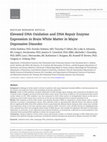Papers by Craig Stockmeier
Death Studies, 2020
The combined presence of depression with alcohol abuse can increase suicide risk. We used psychol... more The combined presence of depression with alcohol abuse can increase suicide risk. We used psychological autopsy to evaluate 101 individuals who died by suicide, to understand relationships between stressful life events, alcohol abuse, and depression. As compared to suicidal adults with depression only, individuals meeting criteria for both a depressive disorder and alcohol use disorder tended to be younger and experienced higher rates of stressful life events during the six months prior to death. Alcohol abuse likely influences interpersonal conflict, financial distress, and legal problems. Interventions focusing on managing life problems may help to reduce suicide risk.

Major depressive disorder (MDD) is a notably complex illness with a lifetime prevalence of 14%.1 ... more Major depressive disorder (MDD) is a notably complex illness with a lifetime prevalence of 14%.1 It is often chronic or recurrent and is thus accompanied by considerable morbidity, excess mortality, substantial costs, and heightened risk of suicide.2-7 MDD is a major cause of disability worldwide.8 We conducted a genome-wide association (GWA) meta-analysis in 130,664 MDD cases and 330,470 controls, and identified 44 independent loci that met criteria for statistical significance. We present extensive analyses of these results which provide new insights into the nature of MDD. The genetic findings were associated with clinical features of MDD, and implicated prefrontal and anterior cingulate cortex in the pathophysiology of MDD (regions exhibiting anatomical differences between MDD cases and controls). Genes that are targets of antidepressant medications were strongly enriched for MDD association signals (P=8.5×10−10), suggesting the relevance of these findings for improved pharmacot...

Progress in Neuro-Psychopharmacology and Biological Psychiatry, 2013
Dysregulation of the glutamatergic system has been implicated not only in the treatment of major ... more Dysregulation of the glutamatergic system has been implicated not only in the treatment of major depressive disorder (MDD), but also in the excitotoxic effects of stress and anxiety on the prefrontal cortex, which may precede the onset of a depressive episode. Our previous studies demonstrate marked deficits in prominent postsynaptic proteins involved in glutamate neurotransmission in the prefrontal cortex (PFC), Brodmann's area 10 (BA 10) from subjects diagnosed with major depressive disorder (MDD). In the same group of subjects we have identified deficits in expression and phosphorylation level of key components of the mammalian target of rapamycin (mTOR) signalling pathway, known to regulate translation initiation. Based on our previous findings, we have postulated that glutamate-dependent dysregulation of mTORinitiated protein synthesis in the PFC may underlie the pathology of MDD. The aim of this study was to use the NanoString nCounter System to perform analysis of genes coding for glutamate transporters, glutamate metabolizing enzymes, neurotrophic factors and other intracellular signaling markers involved in glutamate signaling that were not previously investigated by our group in the PFC BA10 from subjects with MDD. We have analyzed a total of 200 genes from 16 subjects with MDD and 16 healthy controls. These are part of the same cohort used in our previous studies. Setting our cutoff p-value ≤ 0.01, marked upregulation of genes coding for mitochondrial glutamate carrier (GC1; p=0.0015), neuropilin 1 (NRP-1; p=0.0019), glutamate receptor ionotropic N-methyl-D-aspartate-associated protein 1 (GRINA; p=0.0060), and fibroblast

Genes, 2021
Schizophrenia is a genetically complex neuropsychiatric disorder with largely unresolved mechanis... more Schizophrenia is a genetically complex neuropsychiatric disorder with largely unresolved mechanisms of pathology. Identification of genes and pathways associated with schizophrenia is important for understanding the development, progression and treatment of schizophrenia. In this study, pathways associated with schizophrenia were explored at the level of gene expression. The study included post-mortem brain tissue samples from 68 schizophrenia patients and 44 age and sex-matched control subjects. Whole transcriptome poly-A selected paired-end RNA sequencing was performed on tissue from the prefrontal cortex and orbitofrontal cortex. RNA expression differences were detected between case and control individuals, focusing both on single genes and pathways. The results were validated with RT-qPCR. Significant differential expression between patient and controls groups was found for 71 genes. Gene ontology analysis of differentially expressed genes revealed an up-regulation of multiple g...

Journal of psychiatric research, Jan 7, 2018
Astrocyte functions in white matter are less well understood than in gray matter. Our recent stud... more Astrocyte functions in white matter are less well understood than in gray matter. Our recent study of white matter in ventral prefrontal cortex (vPFC) revealed alterations in expression of myelin-related genes in major depressive disorder (MDD). Since white matter astrocytes maintain myelin, we hypothesized that morphometry of these cells will be altered in MDD in the same prefrontal white matter region in which myelin-related genes are altered. White matter adjacent to vPFC was examined in 25 MDD and 21 control subjects. Density and size of GFAP-immunoreactive (-ir) astrocyte cell bodies was measured. The area fraction of GFAP-ir astrocytes (cell bodies + processes) was also estimated. GFAP mRNA expression was determined using qRT-PCR. The density of GFAP-ir astrocytes was also measured in vPFC white matter of rats subjected to chronic unpredictable stress (CUS) and control animals. Fibrous and smooth GFAP-ir astrocytes were distinguished in human white matter. The density of both ...

International Journal of Neuropsychopharmacology, 2016
Background: Pathology of white matter in brains of patients with major depressive disorder (MDD) ... more Background: Pathology of white matter in brains of patients with major depressive disorder (MDD) is well-documented, but the cellular and molecular basis of this pathology are poorly understood. Methods: Levels of DNA oxidation and gene expression of DNA damage repair enzymes were measured in Brodmann area 10 (BA10) and/or amygdala (uncinate fasciculus) white matter tissue from brains of MDD (n=10) and psychiatrically normal control donors (n=13). DNA oxidation was also measured in BA10 white matter of schizophrenia donors (n=10) and in prefrontal cortical white matter from control rats (n=8) and rats with repeated stress-induced anhedonia (n=8). Results: DNA oxidation in BA10 white matter was robustly elevated in MDD as compared to control donors, with a smaller elevation occurring in schizophrenia donors. DNA oxidation levels in psychiatrically affected donors that died by suicide did not significantly differ from DNA oxidation levels in psychiatrically affected donors dying by other causes (non-suicide). Gene expression levels of two base excision repair enzymes, PARP1 and OGG1, were robustly elevated in oligodendrocytes laser captured from BA10 and amygdala white matter of MDD donors, with smaller but significant elevations of these gene expressions in astrocytes. In rats, repeated stress-induced anhedonia, as measured by a reduction in sucrose preference, was associated with increased DNA oxidation in white, but not gray, matter. Conclusions: Cellular residents of brain white matter demonstrate markers of oxidative damage in MDD. Medications that interfere with oxidative damage or pathways activated by oxidative damage have potential to improve treatment for MDD.

Biochimica et Biophysica Acta (BBA) - General Subjects, 2017
Background-Neuropeptide precursors are traditionally viewed as proteins giving rise to small neur... more Background-Neuropeptide precursors are traditionally viewed as proteins giving rise to small neuropeptide molecules. Prodynorphin (PDYN) is the precursor protein to dynorphins, endogenous ligands for the κ-opioid receptor. Alternative mRNA splicing of neuropeptide genes may regulate cell-and tissue-specific neuropeptide expression and produce novel protein isoforms. We here searched for novel PDYN mRNA and their protein product in the human brain. Methods-New PDYN transcripts were identified using nested PCR amplified from oligo(dT) selected full-length capped mRNA. Gene expression was analyzed by qRT-PCR, PDYN protein by western blotting and confocal imaging, dynorphin peptides by radioimmunoassay. Neuronal nuclei were isolated using fluorescence-activated nuclei sorting from postmortem human striatal tissue. Immunofluorescence staining and confocal microscopy was performed for human caudate nucleus.

Journal of Psychiatric Research, 2016
Background-Major depressive disorder (MDD) is a serious psychiatric illness, associated with an i... more Background-Major depressive disorder (MDD) is a serious psychiatric illness, associated with an increasing rate of suicide. The pathogenesis of depression may be associated with the disruption of zinc (Zn) homeostasis. In the brain, several proteins that regulate Zn homeostasis are present, including Zn transporters (ZnTs) which remove Zn from the cytosol. The present study was designed to investigate whether depression and suicide are associated with alterations in the expression of the ZnTs protein. Methods-Protein levels of ZnT1, ZnT3, ZnT4, ZnT5 and ZnT6 were measured in postmortem brain tissue from two different cohorts. Cohort A contained 10 subjects diagnosed with MDD (7 were suicide victims) and 10 psychiatrically-normal control subjects and cohort B contained 11 non-diagnosed suicide victims and 8 sudden-death control subjects. Moreover, in cohort A we measured protein level of NMDA (GluN2A subunit), AMPA (GluA1 subunit) and 5-HT1A receptors and PSD-95. Proteins were measured in the prefrontal cortex (PFC) using Western blotting. In addition, Zn concentration was measured using a voltammetric method.

Bipolar Disorders, 2016
Objectives-Neuroimaging studies note lithium-related increases in the volume of gray matter in pr... more Objectives-Neuroimaging studies note lithium-related increases in the volume of gray matter in prefrontal cortex (PFC) and hippocampus. Postmortem human studies report alterations in neuronal and glial cell density and size in the PFC of lithium-treated subjects. Rodents treated with lithium exhibit cell proliferation in the dentate gyrus (DG) of the hippocampus. However, it is not known whether hippocampal and PFC volume are also increased in these animals or whether cell number in the PFC is altered. Methods-Using stereological methods, this study estimated the total number of neurons, glia and the packing density of astrocytes in the DG and PFC of normal adult mice treated with lithium and evaluated the total volume of these regions and the entire neocortex. Results-Lithium treatment increased the total number of neurons and glia in the DG (25% and 21%, respectively) and the density of astrocytes but did not alter the total number in the PFC. However, the volume of the hippocampus and its subfields, the PFC and its subareas, and the entire neocortex were not altered by lithium. Conclusions-Both neuronal and glial cells accounted for lithium-induced cell proliferation in the DG. That the number of neurons and glia were unchanged in the PFC is consistent with the view that this region is not a neurogenic zone. Further studies are required to clarify the impact of lithium treatment on the PFC under pathological conditions and to investigate the dissociation between increased cell proliferation and unchanged volume in the hippocampus.

Neurobiological Foundation of Aberrant Behaviors, 2002
Despite considerable research efforts, it has been difficult to reach definitive conclusions in p... more Despite considerable research efforts, it has been difficult to reach definitive conclusions in postmortem brain tissue on monoamine receptors and transporters in suicide and affective disorders. Most studies cannot be directly compared for a number of methodological reasons. Critical issues to control in future postmortem brain studies include variables such as the cause of death (e.g. suicide), the specific psychiatric diagnoses of the subjects, long-term medication histories, psychoactive substance use by the subjects, smoking history, the hemisphere from which tissues were dissected, and the specific cytoarchitectonic region to be evaluated. Carefully controlled studies with larger numbers of subjects will ensure a greater likelihood of reaching a consensus on the influence of suicide and psychiatric history on monoaminergic markers in postmortem brain tissue.

Neurotoxicity research, Jan 5, 2015
Major depressive disorder and alcoholism are significant health burdens that can affect executive... more Major depressive disorder and alcoholism are significant health burdens that can affect executive functioning, cognitive ability, job responsibilities, and personal relationships. Studies in animal models related to depression or alcoholism reveal that the expression of Krüppel-like factor 11 (KLF11, also called TIEG2) is elevated in frontal cortex, which suggests that KLF11 may play a role in stress- or ethanol-induced psychiatric conditions. KLF11 is a transcriptional activator of monoamine oxidase A and B, but also serves other functions in cell cycle regulation and apoptotic cell death. In the present study, immunohistochemistry was used to quantify intensity of nuclear KLF11, combined with an unbiased stereological approach to assess nuclei in fronto-limbic, limbic, and other brain regions of rats exposed chronically to social defeat or ethanol. KLF11 immunoreactivity was increased significantly in the medial prefrontal cortex, frontal cortex, and hippocampus of both stressed r...

Alcoholism, clinical and experimental research, Jan 19, 2015
Brain cell death is a major pathological consequence of alcohol neurotoxicity. However, the molec... more Brain cell death is a major pathological consequence of alcohol neurotoxicity. However, the molecular cascades in alcohol-induced brain tissue injury are unclear. Using Western blot and double immunofluorescence, we examined the expression of interferon (IFN)-induced protein kinase R (PKR), phosphorylated-PKR (p-PKR), and IFN gamma (IFNγ) in the prefrontal cortex (PFC) of postmortem brains from subjects with alcohol use disorders (AUD). The protein levels of PKR, p-PKR, and IFNγ were significantly increased in subjects with AUD compared with control subjects without AUD, and a younger age of onset of AUD was significantly correlated with higher protein levels of p-PKR. In addition, elevated PKR- and p-PKR-IR were observed in both neurons and astrocytes in the PFC of subjects with AUD compared to subjects without AUD. The activation of the IFNγ-PKR pathway in PFC of humans is associated with chronic excessive ethanol use with an age of onset dependent manner, and activation of this p...

International Journal of Neuropsychopharmacology, 2009
A variety of studies have documented alterations in 5-HT 1A receptor binding sites in the brain o... more A variety of studies have documented alterations in 5-HT 1A receptor binding sites in the brain of subjects with major depressive disorder (MDD). The recently identified transcription factor, nuclear deformed epidermal autoregulatory factor (NUDR/Deaf-1) has been shown to function as a transcriptional modulator of the human 5-HT 1A receptor gene. The present study was undertaken to document the regional and cellular localization of NUDR in the human prefrontal cortex and to examine the levels of NUDR and 5-HT 1A receptor protein in prefrontal cortex of female and male depressed and control subjects. NUDR immunoreactivity was present in neurons and glia across cortical layers and was co-localized with 5-HT 1A receptor immunoreactive neurons. NUDR immunoreactivity as measured by Western blot was significantly decreased in the prefrontal cortex of female depressed subjects (42 %, p=0.02) and unchanged in male depressed subjects relative to gender-matched control subjects. Similarly, 5-HT 1A receptor protein level was significantly reduced in the prefrontal cortex of female depressed subjects (46 %, p=0.03) and unchanged in male depressed subjects compared to gender-matched control subjects. Reduced protein expression of NUDR in the prefrontal cortex of female subjects with MDD may reflect a functional alteration in this transcription factor, which may contribute to the decrease in 5-HT 1A receptors observed in the same female subjects with MDD. In addition, the gender-specific alterations in cortical NUDR and 5-HT 1A receptor proteins could represent an underlying biological mechanism associated with the higher incidence of depression in women.

Brain structure & function, Jan 7, 2014
Functional imaging studies consistently report abnormal amygdala activity in major depressive dis... more Functional imaging studies consistently report abnormal amygdala activity in major depressive disorder (MDD). Neuroanatomical correlates are less clear: imaging studies have produced mixed results on amygdala volume, and postmortem neuroanatomic studies have only examined cell densities in portions of the amygdala or its subregions in MDD. Here, we present a stereological analysis of the volume of, and the total number of, neurons, glia, and neurovascular (pericyte and endothelial) cells in the basolateral amygdala in MDD. Postmortem tissues from 13 subjects with MDD and 10 controls were examined. Sections (~15/subject) taken throughout the rostral-caudal extent of the basolateral amygdala (BLA) were stained for Nissl substance and utilized for stereological estimation of volume and cell numbers. Results indicate that depressed subjects had a larger lateral nucleus than controls and a greater number of total BLA neurovascular cells than controls. There were no differences in the num...

Alcoholism, clinical and experimental research, 2014
Alcohol-dependent (ALC) subjects exhibit glial and neuronal pathology in the prefrontal cortex (P... more Alcohol-dependent (ALC) subjects exhibit glial and neuronal pathology in the prefrontal cortex (PFC). However, in many patients, neurophysiological disturbances are not associated with catastrophic cell depletion despite prolonged alcohol abuse. It is still unclear how some relevant markers of a cell's propensity to degenerate or proliferate are changed in the PFC of ALC subjects without major neurological disorders. Levels of pro-apoptotic caspase 8 (C8), X-linked inhibitor of apoptosis protein (XIAP), direct IAP binding protein with low pI (DIABLO), proliferating cell nuclear antigen (PCNA), and density of cells immunoreactive for proliferation marker Ki-67 (Ki-67-IR) were measured postmortem in the left orbitofrontal cortex (OFC) of 29 subjects with alcohol dependence and 23 nonpsychiatric comparison subjects. Alcohol subjects had significantly higher levels of the 14 kDa C8 fragment (C8-14), an indicator of C8 activation. However, there was no change in the levels of DIABLO,...

Neuropsychopharmacology, 2011
The novel transcriptional repressor protein, R1 (JPO2/CDCA7L/RAM2), inhibits monoamine oxidase A ... more The novel transcriptional repressor protein, R1 (JPO2/CDCA7L/RAM2), inhibits monoamine oxidase A (MAO A) gene expression and influences cell proliferation and survival. MAO A is implicated in several neuropsychiatric illnesses and highly elevated in major depressive disorder (MDD); however, whether R1 is involved in these disorders is unknown. This study evaluates the role of R1 in depressed subjects either untreated or treated with antidepressant drugs. R1 protein levels were determined in the postmortem prefrontal cortex of 18 untreated MDD subjects and 12 medicated MDD subjects compared with 18 matched psychiatrically normal control subjects. Western blot analysis showed that R1 was significantly decreased by 37.5% (po0.005) in untreated MDD subjects. The R1 level in medicated MDD subjects was also significantly lower (by 30%; po0.05) compared with control subjects, but was not significantly different compared with untreated MDD subjects. Interestingly, the reduction in R1 was significantly correlated with an increase (approximately 40%; po0.05) in MAO A protein levels within the MDD groups compared with controls. Consistent with the change in MAO A protein expression, the MAO A catalytic activity was significantly greater in both MDD groups compared with controls. These results suggest that reduced R1 may lead to elevated MAO A levels in untreated and treated MDD subjects; moreover, the reduction of R1 has been implicated in apoptotic cell death and apoptosis has also been observed in the brains of MDD subjects. Therefore, modulation of R1 levels may provide a new therapeutic target in the development of more effective strategies to treat MDD.

Nature Medicine, 2014
Major depressive disorder (MDD) affects up to 17% of the population, causing profound personal su... more Major depressive disorder (MDD) affects up to 17% of the population, causing profound personal suffering and economic loss (1). Clinical and pre-clinical studies have revealed that prolonged stress and MDD are associated with neuronal atrophy of cortical and limbic brain regions (2-9), but the molecular mechanisms underlying these morphological alterations have not yet been identified. Here, we show that stress increases levels of REDD1 (regulated in development and DNA damage responses 1), an inhibitor of mTORC1 (mammalian/mechanistic target of rapamycin complex 1) (10), in rat prefrontal cortex (PFC). This is concurrent with a decrease in phosphorylation of signaling targets of mTORC1, which is implicated in protein synthesisdependent synaptic plasticity. We also found that REDD1 levels are increased in the postmortem PFC of human subjects with MDD relative to matched controls. Mutant mice with a deletion of Users may view, print, copy, and download text and data-mine the content in such documents, for the purposes of academic research, subject always to the full Conditions of use:

Uploads
Papers by Craig Stockmeier